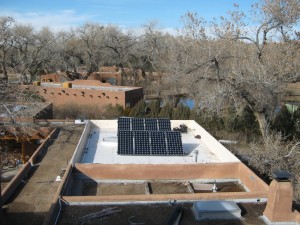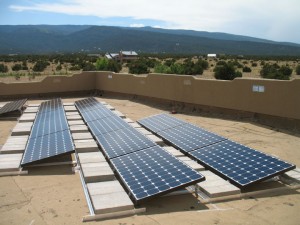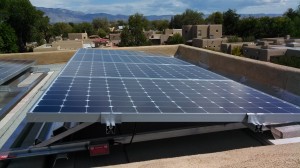I opened my electric bill a couple of weeks ago and my mouth just about dropped open…the bill was for $351.37!!! And only a month ago it was over $370.00!! I realized right there and then drastic action had to be taken if we were going to continue to afford our utility bills for our all-electric 2,500 square foot home with refrigerated air. I absolutely love our home—it was a foreclosure that we bought ten months ago that met our needs in every way—, but I feared that paying to live here comfortably would soon be unmanageable. So, I started to do extensive research into solar energy, specifically “active solar” and photovoltaic panels. What I soon realized was now is the perfect time to invest in this resource because of its ecological, financial and added real estate values.
The first thing I became sure of was that I wanted an active solar photovoltaic system, and not the clunky passive solar systems that appeared in the 70’s. The key difference is the modern technology’s ability to store energy. In the past the antiquated system required people to take mid-day showers or only bathe when it was sunny so as to not risk ice-cold water flowing from the faucets. Although I’m no expert on the subject, I understand that the way active solar works is that when the sun is shining photovoltaic panels trap the sun’s energy, converting it to electricity for consumption at any time of day. When the panels trap more energy than is used the excess solar production is sold back to the power company which is referred to as “net metering.”
Right now our local power company PNM pays solar panel owners $0.04 for every kilowatt hour sold back to the grid. Apparently, there are rumblings the rate will go down to $0.035/kilowatt hour, but no one knows for sure. Conceivably, the more people that supply energy back to the grid, the less the power company will pay. If that’s the case it would make sense to take advantage of the higher buy-back rate while we still can.
The tax incentives are absolutely huge. Presently, the federal government will credit the homeowner 30% of the cost of the panels and the state of New Mexico, a 10% credit (with a $9,000 cap). Another tax incentive is that locally, solar panel installations are exempt from Gross Receipts Tax which here in Albuquerque is 7%. The possibility of having the government pay close to ½ of your investment really is quite enticing. Since we don’t know what kind of incentives (if any) the future will bring, you really don’t want to leave this kind of money sitting right there on the table.
Finally, as a Realtor® the one thing I wanted to be sure of is that photo voltaic panels add value to homes when sold on the real estate market. Unfortunately, right now there just isn’t enough data at the local level to support any claim of value. We real estate agents live and die by the phrase “where are your comps (comparables)?”, and there simply aren’t enough homes sold with solar panels versus homes without them. But how can we measure the value active solar adds to a listing?! When asked this question an appraiser colleague provided me with the following formula: Additional Value = 7 Years Savings Due to Solar Panels. In my own case, that would mean that my panels would add $19,500+ of value to my house if I decided to sell it. Sweet!
In a study conducted by Ernest Orlando Lawrence, Berkeley National Laboratory titled, “An Analysis of the Effects of Residential Photovoltaic Energy Systems on Home Sales Prices in California,”* it states that there is, “[…]strong evidence that homes with PV [photovoltaic] systems in California have sold for a premium over comparable homes without PV system. […] estimates for average PV premiums range from $3.9 to $6.4 per installed watt (DC) among a large number of different model specifications, with most models coalescing near $5.5/watt.” Again, applied to my own situation, if I took the more conservative number since we’re not in California ($3.9/installed watt), photovoltaic panels would add over $35,700 worth of value to my property (even sweeter!).
But is it only about the money? Isn’t it also about the fact that we should reduce our reliance on fossil fuels which is an ever-diminishing resource? Solar energy is clean and sustainable, and—living smack, dab in the middle of the sun belt—is quite plentiful. So, don’t ask yourself, “why is now the time?”, rather, “why is now NOT the time?”
(Stay tuned for my next segment, covering the solar panel installation process.)
*I would be happy to provide this document to anyone who requests it and sit down for coffee to discuss my thought-process.


